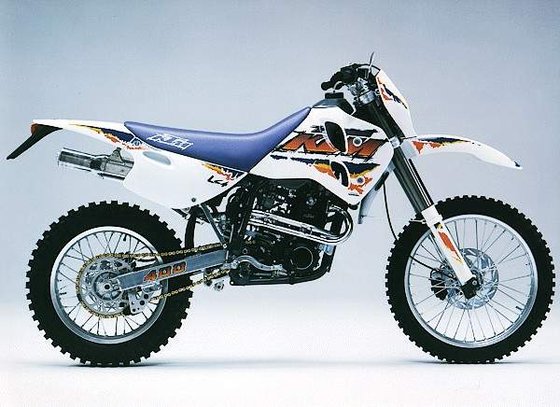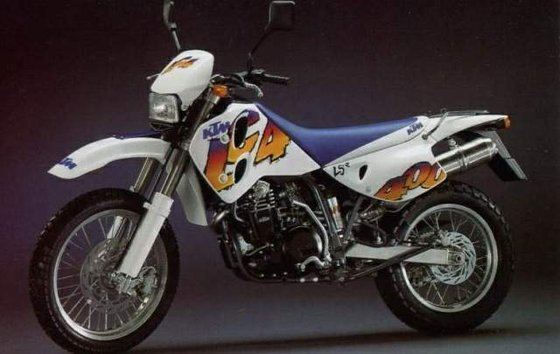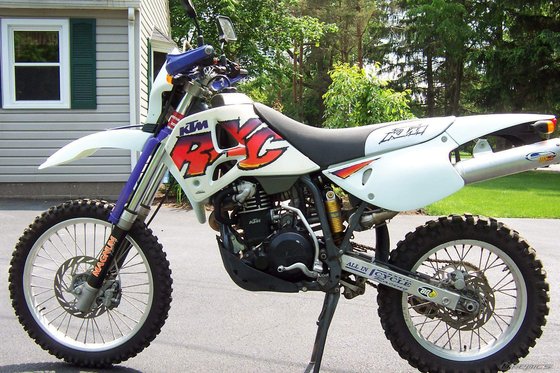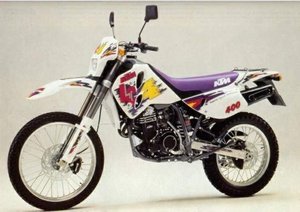KTM 400 LC4 [1996–2001]: The Off-Road Maverick That Redefined Dual-Sport Riding

Introduction
The KTM 400 LC4, produced from 1996 to 2001, stands as a defining chapter in the story of dual-sport motorcycles. This Austrian machine wasn’t just a bridge between dirt and pavement—it was a declaration that a street-legal bike could dominate off-road trails with uncompromising aggression. Designed for riders who refused to choose between adventure and practicality, the LC4 generation blended KTM’s race-bred engineering with rugged durability. Over six years, it evolved into a cult classic, earning respect for its raw power, lightweight chassis, and trail-savvy suspension. Let’s dive into what makes this bike a timeless contender for dirt enthusiasts and weekend explorers alike.
Riding Experience: Where the LC4 Shines
Off-Road Dominance
Swinging a leg over the KTM 400 LC4, the first thing you notice is its commanding seat height—ranging from 870 mm (34.3 inches) to 940 mm (37 inches), depending on the submodel. While this might intimidate shorter riders, it pays dividends in ground clearance when tackling rocky ascents or deep ruts. The LC4 feels at home on technical single-track trails, where its 136–138 kg (299–304 lbs) dry weight allows quick direction changes. Unlike bulkier dual-sports, this bike forgives mistakes: clip a tree with the handlebar? A quick tug corrects your line without drama.
The LC4’s narrow profile (a redesign highlight in later models) lets you grip the tank effortlessly with your knees, translating to precise control in tight switchbacks. On fast fire roads, the WP suspension soaks up chatter while maintaining composure over sudden drops. Even at 155 km/h (96 mph)—the bike’s top speed—the chassis feels stable, though knobby tires and a tall seat remind you this isn’t a tarmac-focused machine.
On-Road Manners
For a bike designed to conquer trails, the LC4 surprises with its pavement competence. The liquid-cooled 398cc single-cylinder engine delivers smooth power delivery at highway speeds, though vibrations creep in above 100 km/h (62 mph). Commuting? It’s doable, but the upright riding position and minimal wind protection make long slogs exhausting. Where it excels is connecting trailheads: the 12L (3.17-gallon) fuel tank offers decent range, and the inclusion of DOT-approved lights and mirrors (in R/XC models) keeps you legal between dirt sessions.

Engine Performance: The Heart of a Trail Beast
Power and Character
The LC4’s 398cc engine evolved across its production run, with power outputs ranging from 34 HP (25 kW) to a spirited 50 HP (37 kW) in later EGS models. Even the base 34 HP variant packs a punch, thanks to a power-to-weight ratio of 0.25–0.37 HP/kg. Throttle response is immediate, with a linear powerband that avoids the abruptness of two-strokes. Low-end torque pulls strongly from idle, making it a master of hill climbs and log hopping.
Carburetion was a mixed bag. Early models used Dell’Orto carbs, while later versions adopted Qwiksilver units to meet emissions standards. Cold starts could be finicky—the kickstart-only models demand technique, but once warm, the engine fires reliably. Riders praise the LC4’s durability: the liquid-cooled design prevents overheating on slow crawls, and the single-cylinder simplicity means fewer parts to fail mid-adventure.
Transmission and Gearing
The 5-speed gearbox is bulletproof, though tall stock gearing (16/45 on R/XC models) prioritizes road legality over trail agility. Swapping to a smaller front sprocket transforms the bike off-road, allowing second-gear pulls through technical sections. Clutch action is heavy but predictable, a fair trade-off for its ruggedness.

Chassis and Suspension: Built for the Brutal
Frame and Ergonomics
KTM’s chromoly steel frame strikes a balance between flex and rigidity. It’s stiff enough for aggressive cornering but absorbs impacts without transferring shock to the rider. Standing up on the pegs feels natural, with wide handlebars offering leverage to muscle through sand or mud. The slim fuel tank (narrowed in post-1996 models) enhances rider movement, a stark contrast to the bloated feel of Japanese competitors.
Suspension Setup
- Front: 43 mm inverted Marzocchi forks (later models) or WP USD forks provide 295 mm (11.6 inches) of travel. They’re plush over small bumps yet resist bottoming on hard landings.
- Rear: A WP monoshock (or Öhlins on premium trims) delivers 320 mm (12.6 inches) of wheel travel. Rebound and compression damping adjustments let you tailor the ride for everything from motocross tracks to rocky descents.
Brakes and Wheels
Single discs front and rear deliver adequate stopping power, though modern riders might crave more bite during high-speed descents. The Pirelli MT21 tires (on R/XC models) are a competent compromise for mixed terrain but swap to aggressive knobbies for serious mud or sand.
Competition: How the LC4 Stacks Up
Honda XR650L
The XR650L is the LC4’s closest Japanese rival. While Honda’s air-cooled engine is bulletproof, it feels anemic compared to the KTM’s liquid-cooled grunt. The XR also weighs 30 kg (66 lbs) more, a glaring handicap in technical terrain. However, Honda’s dealer network and lower maintenance needs appeal to casual riders.
Suzuki DR350S
Lighter and cheaper than the LC4, the DR350S struggles with soft suspension and a less precise gearbox. It’s a fine beginner bike but lacks the KTM’s race-ready edge.
Husaberg FE400e
This Swedish contender matches the LC4’s power and weight but suffers from spotty parts availability. KTM’s aftermarket support (and MOTOPARTS.store’s inventory) gives it a clear advantage for long-term ownership.
Maintenance: Keeping Your LC4 Alive
Key Considerations
- Oil Changes: Every 15–20 hours of riding. Use a high-quality 10W-50 synthetic to protect the LC4’s high-revving engine.
- Valve Adjustments: Check every 30 hours. The 4-valve head requires precise shim adjustments—keep a feeler gauge handy.
- Air Filter Care: Clean after every dusty ride. Upgrade to a twin-air filter for better airflow and debris protection.
- Carb Tuning: Qwiksilver carbs demand attention. Jet kits from MOTOPARTS.store can optimize performance for your altitude.
- Suspension Service: Rebuild forks and shock every 100 hours. Stiction is the enemy—keep seals lubricated.
Common Upgrades
- Sprockets: A 14-tooth front sprocket improves trail responsiveness.
- Exhaust: Aftermarket slip-ons shed weight and unlock hidden horsepower.
- Handguards: Mandatory for bushwhacking—save your levers from destruction.
Conclusion: The Legacy of a Dual-Sport Icon
The KTM 400 LC4 wasn’t just a motorcycle—it was a statement. In an era when “dual-sport” often meant compromised off-road performance, KTM dared to build a machine that thrived in the dirt while ticking legal boxes for the road. Its combination of lightweight agility, robust suspension, and tunable engine ensures it remains relevant decades later. Whether you’re hunting for a vintage project bike or upgrading your current LC4 with modern components, MOTOPARTS.store has the expertise and inventory to keep your Austrian warrior conquering trails for years to come.
Specifications sheet
| Engine | |
|---|---|
| Stroke: | Four-stroke |
| Starter: | Kick (Electric on some models) |
| Max power: | 41 kW | 55.0 hp |
| Max torque: | 63 Nm |
| Fuel system: | Carburetor (Qwiksilver) |
| Max power @: | 8500 rpm |
| Displacement: | 398 ccm |
| Configuration: | Single |
| Cooling system: | Liquid |
| Compression ratio: | 11.5:1 |
| Number of cylinders: | 1 |
| Dimensions | |
|---|---|
| Wheelbase: | 1510 mm (59.4 in) |
| Dry weight: | 137 |
| Seat height: | 870–940 mm (34.3–37.0 in) |
| Ground clearance: | 165 mm (6.5 in) |
| Fuel tank capacity: | 8.5–12.0 L (2.2–3.2 US gal) |
| Drivetrain | |
|---|---|
| Final drive: | chain |
| Transmission: | 5-speed |
| Rear sprocket: | 45 |
| Front sprocket: | 16 |
| Maintenance | |
|---|---|
| Rear tire: | 140/80-18 |
| Engine oil: | 10W40 |
| Front tire: | 90/90-21 |
| Brake fluid: | DOT 4 |
| Spark plugs: | NGK CR8E or NGK CR8EIX |
| Engine oil capacity: | 2.0 |
| Engine oil change interval: | Every 5000 km or annually |
| Valve clearance check interval: | 24,000 km (15,000 mi) |
| Performance | |
|---|---|
| Top speed: | 155 km/h (96.3 mph) |
| Power/weight ratio: | 0.299–0.365 HP/kg |
| Chassis and Suspension | |
|---|---|
| Frame: | Steel/aluminum (varies by submodel) |
| Rear brakes: | Single disc |
| Front brakes: | Single disc |
| Rear suspension: | WP monoshock, adjustable rebound and compression |
| Front suspension: | 43 mm upside-down telescopic fork |
| Rear wheel travel: | 320 mm (12.6 in) |
| Front wheel travel: | 295 mm (11.6 in) |



















